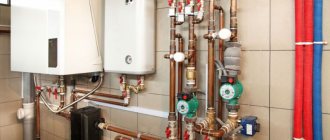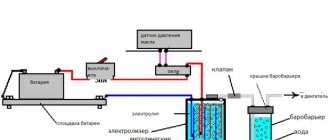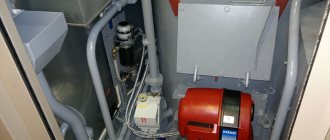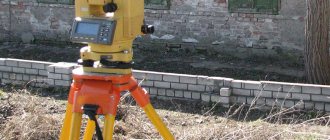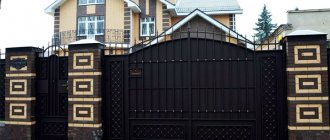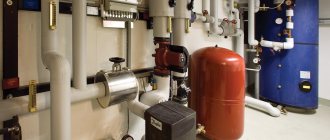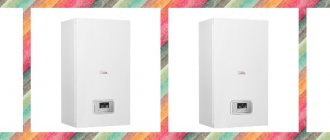Home » Central heating » Combined
Owners of private houses who do not have the opportunity to install gas equipment can try the heating option with a combined heating system. Such heating heats the room efficiently, and creates comfort and coziness in it.
Combined heating system
Features of the mixed heating system
Before purchasing a heating boiler for a summer cottage or a private home, you need to familiarize yourself with the power parameters of the device. When designing such work, the area of the room and heating needs are taken into account. Various combinations of heating systems are considered, having three principles:
- thermal energy can be obtained from different sources;
- it is generated, stored and transformed. Subsequently, it is used rationally;
- a combined heating system can be created at the beginning of construction of a facility or already completed living space.
Quite often you can find a mixed heating system in private houses. This is very convenient and allows you to switch between different types of fuel.
The process of switching between fuel types does not take much time. There are no special changes in the equipment settings. Even due to different fuel prices, this option is more acceptable.
Combined heating system diagram
Single-pipe heating system diagram
Single-pipe heating system: vertical and horizontal distribution.
In a single-pipe heating system, the supply of hot coolant (supply) to the radiator and the removal of cooled coolant (return) are carried out through one pipe. All devices relative to the direction of movement of the coolant are connected to each other in series. Therefore, the temperature of the coolant at the inlet of each subsequent radiator along the riser is significantly reduced after heat is removed from the previous radiator. Accordingly, the heat transfer of radiators decreases with distance from the first device.
Such schemes are used mainly in old central heating systems of multi-storey buildings and in autonomous gravity-type systems (natural coolant circulation) in private residential buildings. The main defining disadvantage of a single-pipe system is the impossibility of independently adjusting the heat transfer of each radiator separately.
To eliminate this drawback, it is possible to use a single-pipe circuit with a bypass (a jumper between the supply and return), but in this circuit, the first radiator on the branch will always be the hottest, and the last the coldest.
Multi-storey buildings use a vertical single-pipe heating system.
In multi-storey buildings, the use of such a scheme allows saving on the length and cost of supply networks. As a rule, the heating system is made in the form of vertical risers passing through all floors of the building. The heat output of radiators is calculated during system design and cannot be adjusted using radiator valves or other control fittings. Given modern requirements for comfortable indoor conditions, this scheme for connecting water heating devices does not satisfy the requirements of residents of apartments located on different floors, but connected to the same heating system riser. Heat consumers are forced to “endure” overheating or underheating of air temperature during the transitional autumn and spring period.
Single-pipe heating in a private house.
In private houses, a single-pipe scheme is used in gravity heating networks, in which hot water circulates due to the differential densities of heated and cooled coolants. Therefore, such systems are called natural. The main advantage of this system is energy independence. When, for example, in the absence of a circulation pump in the system connected to the power supply networks and in the event of power outages, the heating system continues to function.
The main disadvantage of the gravity single-pipe connection scheme is the uneven distribution of coolant temperature across the radiators. The first radiators on the branch will be the hottest, and as you move away from the heat source, the temperature will drop. The metal consumption of gravity systems is always higher than that of forced ones due to the larger diameter of the pipelines.
Video about the installation of a single-pipe heating circuit in an apartment building:
Design features
A heating boiler has several combustion chambers, usually two, for different types of fuel. One compartment, for example, is solid fuel, the second is liquid (diesel fuel or antifreeze). This combination makes it possible to connect an autonomous line and set individual temperatures in any part of the room. For example, one line supplies heat to radiators, the other to heated floors.
The latest models of combined heating in a private house have heating elements for heating with electricity. There are also types with gas burners or with compartments for diesel fuel. You just need to turn the switch to the desired position. To save money, it is recommended to use a heat accumulator. It is more expedient to use it in wood-burning boiler equipment. When using solid fuels, the power of the boiler equipment is not regulated, and the room becomes very hot. It is for these purposes that a heat accumulator is needed. It performs some functions:
We recommend: How to choose a collector for a combined heating system?
- conserves excess heat;
- in case of lack of temperature in the hot water supply or system, depreservation occurs.
Thanks to this, there is no need to constantly switch the boiler. It is enough to turn it on once.
How to combine heating devices?
We are accustomed to the fact that in city apartments central heating radiators are widely used as a heating device. It is they who, with a centralized heat supply, provide coziness and a comfortable temperature in our homes.
Radiators and heated floors
Recently, heated floors have been added to radiators, which operate either on water or electricity. Indeed, in this case, the level of comfort increases significantly due to the fact that heating occurs under our feet, and then the heat rises to the top.
It is worth remembering that the presence of a heated floor does not force us to completely abandon radiators. The combination of these two types of heating devices is the same combined version of the heating system of a private house, when the necessary harmony and comfort is achieved. The following proportion is considered optimal: 70% of the heat in the house comes from underfloor heating, and only 30% from central heating radiators. To make this happen, you need to heat the coolant for the floor to 60°C, and the one that goes to the radiators to 75°C.
If the combination of underfloor heating and heating radiators is based on the use of electrical energy, then the batteries will be electric, and the floor will be heated using a special cable
This combined system usually uses:
- Electricity. To do this, a special heating cable is placed underground, and electric batteries are used in the rooms.
- Coolants. Pipes are laid under the floors, and ordinary radiators are installed in the rooms.
When a coolant is used as heating energy, a wide variety of pipes can be used. The materials used for them are copper, metal-plastic, polyethylene, and so on. It is important to correctly calculate the need for pipes, make a reasonable laying scheme and, when making calculations, do not forget about the pump power, the thickness of the pipes and the force of hydraulic resistance. Similar calculations are used to determine the need for radiators for a specific room.
Using water as a coolant, we will use pipes for heated floors. And we will have the most ordinary heating radiators - with hot water inside
To reduce the costs associated with the operation of combined systems, you can install the same radiators only where there is a real need for them: in storerooms and in some other technical premises they are not needed. But with the onset of real frosts, it is better not to skimp on your own health, but to warm up the premises at full capacity. And here is what the collector looks like for this combination:
You can learn more about installing such a home heating system from our material with instructions:.
Warm walls
Another possible combination in the heating system: you can use wall heating together with or instead of a heated floor. Just as in the case of floors, tubes are laid into the wall structure through which the coolant will circulate. When heating the walls, the heat will spread evenly, although there will be no highly heated surfaces in the room.
When making warm walls in your home, you should remember that you need to be extremely careful when hammering nails into them to decorate them with pictures or sconces.
Heat propagation occurs mainly through infrared radiation. Such flows are very favorably perceived by our body. If heated water is used as a coolant, then the pipes are connected in separate branches using a radial circuit.
By the way, walls can be used not only for heating, but also for cooling the room. If in winter we need warmth, then in hot summer none of us will refuse the coolness that will remain in the room if cold water is passed through the pipes. Such cooling will be very useful.
Types of combined heating systems
A combined heating system for a private home can include various coolants, thanks to which the devices can be divided into the following types:
- gas plus diesel boiler equipment. This design can be made of cast iron or steel, or combines both materials. Owners of private houses with a gas pipeline nearby use combined boilers - diesel fuel plus gas. This boiler model is very economical;
- gas plus solid fuel equipment. This system combines gas mixed with solid fuel. Such equipment can be multi-fuel, since it is possible to use firewood and coal. This combined equipment is not entirely effective. The device does not have automatic switching. Even because the design is quite complex, such a device is in demand due to its low and favorable price;
- solid fuel plus electrical equipment. Combined heating of a private house with wood and electricity to heat the room, this combination can very often be seen in country houses. The power connection is to electricity - 220 or 380 Volts, with a power of 5-8 kW. While the owners are in the mansion, general heating is carried out with wood or coal; after leaving and burning the fuel, the temperature in the boiler drops and a relay is activated, turning on the electrical equipment. Thus, during the absence of the owners, the system itself maintains the desired temperature in the room. This device is not cheap, but the result is worth it. But you can be absolutely confident in the reliability of the device;
- gas plus solid fuel and electrical equipment. Perhaps, this type of combined heating boilers for a private home can rightfully be called the best. Because it already runs on three types of fuel, this means that the efficiency of the heating system increases. This design can be installed in any area, but must be equipped with a gas pipeline. If for any reason there are interruptions in gas and electricity, owners will always be able to use any type of solid fuel;
- pyrolysis plus electrodes. This device is suitable for heating a country house. By combining a pyrolysis and electrode boiler, it becomes possible to maintain the desired room temperature, even in the absence of the owners. The system consists of two multi-fuel devices and is very popular.
Solid fuel and electric heating
How to properly heat a private home
With a large selection of heating devices, you can’t help but try to heat the room yourself; for this you need to know some rules and be able to use the equipment. Nowadays, country life has become a priority. There is a 24-hour hot water supply. It became possible to heat the room at will. You can heat it hot, or, on the contrary, you can make it cooler. It all depends on the wishes of the owners.
We recommend: How to choose a collector for a combined heating system?
In order to equip a combined heating system, it is necessary to draw up a project. It must be approved by the relevant organizations. If mixed heating includes gas equipment, you will have to suffer even more with other documents and their certification.
Heating a private house
The mixed type of heating the premises of a private house is a real breakthrough in the field of heat provision. Modern boiler equipment uses different fuels - it all depends on individual needs. Each type of fuel has its own disadvantages, but if you combine them correctly, you will be able to choose the most effective type of heating for a private home.
YouTube responded with an error: The request cannot be completed because you have exceeded your quota.
- Related Posts
- How to choose a collector for a combined heating system?
- Features of combined heating of carriages
